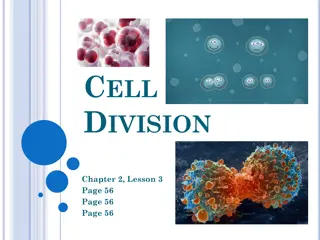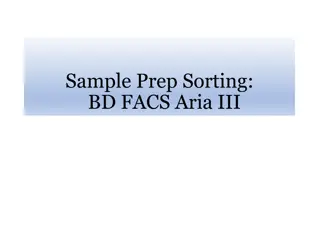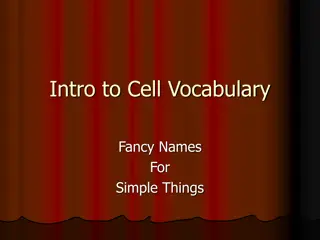Exploring Cell Structures: An Interactive Science Lesson
Dive into the fascinating world of cells with this engaging science lesson. Discover the components of plant and animal cells, learn about organelles, and explore the differences and similarities between these fundamental building blocks of life. Through activities, visuals, and self-assessment, students will deepen their understanding of cell structure and function.
Download Presentation

Please find below an Image/Link to download the presentation.
The content on the website is provided AS IS for your information and personal use only. It may not be sold, licensed, or shared on other websites without obtaining consent from the author. Download presentation by click this link. If you encounter any issues during the download, it is possible that the publisher has removed the file from their server.
E N D
Presentation Transcript
Friday, 26 July 2024 Welcome to Science! On the front of your book you need Your Name . Science . Your Teachers Name .
Friday, 26 July 2024 Every Lesson Expectations 1. Your planners must be on your desk open to the right week. 2. You must have the CW underlined in the top left hand corner of your book. 3. You must have the date and title underlined. 4. You start your DNA activity straight away. 5. Mr Sullivan CW 9th September 2020 Plant and Animal Cells DNA:
Plant & Animal Cells Do now activity: Draw what you think an animal and plant cell looks like I think an animal cell looks like . I think a plant cell looks like
Progress indicators GOOD PROGRESS: Label and Describe the functions of the components of cells OUTSTANDING PROGRESS: Compare the similarities and differences between animal and plant cells.
Word Consciousness You should write down the title and make a note of the key word below. Over the course of the year you ll have created a bank of key words and definitions. Organelles: Small components that make up cells.
If you look at cells down a microscope you will see that they are made up of lots of smaller components these smaller structures are called organelles. Task: Watch the Cells Rap and try to name as many organelles as you can! https://www.youtube.com/watch?v=-zafJKbMPA8
Self-assessment: Mitochondria Nucleus Organelles Vacuole Cell Wall Cytoplasm Cell Chloroplast membrane
What is a cell? Animal and plant cells come in different shapes and sizes, but they all have these basic features: cell membrane vacuole mitochondria chloroplast cytoplasm nucleus Cell wall plant cell animal cell Task: Animal and Plant Cells both have Plant Cells have these extra organelles
Self-assessment: Similarities: Both animal and plant cells have a nucleus, cell membrane, cytoplasm and mitochondria. Differences: Plant cells contain chloroplasts, a cell wall and a vacuole, whereas animal cells do not.
Comprehension Task: Animal & Plant Cells Task: In pairs, read the information sheet on animal and plant cell structures. Complete the questions in your books.
Cell Diagram Both animals and plant cells have a nucleus; this is where the DNA is located. The nucleus is a round dark structure and it controls what happens in the cell. Around the nucleus is a jelly like substance called the cytoplasm, this makes up the interior of the cell and it is where all of the chemical reactions take place. Both Plants and animal cells have a structure around them which controls what goes into and out of the cells. This is called the cell membrane. Around the cell membrane of plant cells is a cell wall, this gives the cell structure. Animal cells do not have a cell wall. Plant cells also have a vacuole, large vacuoles are only found in plant cells, and their job is to keep the cell turgid (firm). Plant cells have chloroplasts, they are green and their function is to absorb sunlight which is then used in photosynthesis (how the plant makes its own food). Both plant and animal cells contain mitochondria these are structures which have folds on the inside, they help the cell release energy from food. Answer the questions in your book: 1. Label the animal and the plant cell using the information above. 2. Which part of the cell contains the DNA? 3. What is the function of the cell membrane? 4. Which parts of the cell are only found in plant cells? 5. What is photosynthesis and where does it happen? 6. Does photosynthesis happen in animal cells? Explain why. 7. Where do chemical reactions take place?
Self-assessment: 1. 2. DNA is found within the nucleus. 3. The cell membrane controls what enters and leaves the cell. 4. Chloroplasts, cell walls and vacuoles are only found in plant cells. 5. Photosynthesis is a process by which plant cells utilize sunlight to synthesis glucose (food), this process occurs in the chloroplasts. 6. Animal cells cannot carry out photosynthesis as these cells do not contain chloroplasts. 7. Chemical reactions take place in the cytoplasm of both animal and plant cells.
Organelle Function Task: Draw this table in your books, you will each be given a piece of information about one of these cell structures and it s your job in the cell, walk around the classroom to find out the rest!! Part name cell surface membrane Function cell wall chloroplast cytoplasm nucleus vacuole Mitochondria
Self-assessment: Part name cell surface membrane Function Controls what enters and leaves the cell. cell wall Supports the cell, made of a tough fibre called cellulose which provides rigidity. Contains chlorophyll which trap energy from the sun, this is used to make food via photosynthesis. Where the chemical reactions of the cells take place. chloroplast cytoplasm nucleus This controls the cell and contains genetic material; genetic information is needed to make new cells. This contains cell sap and is used to store substances and keep the cell firm. Where respiration takes place, respiration is a reaction that transfers energy for the organism. vacuole Mitochondria
Plenary: One thing I now know that I didn t know before this lesson is . One question I still have is .























